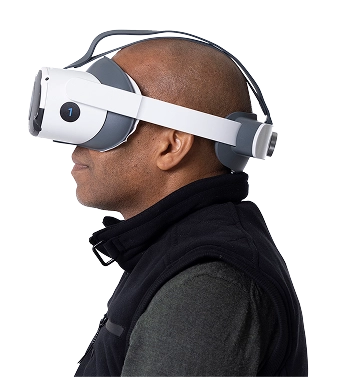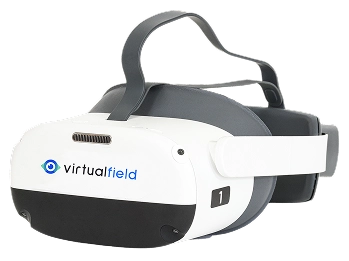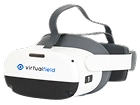Patients usually don’t notice their peripheral vision until it’s lost or reduced. At that point, they may realize they struggle with spatial orientation or miss hazards that fall outside their line of vision. They may have normal central visual acuity, but significant loss at the periphery. The 60-4 visual field exam measures these changes, especially when they’re related to neurological conditions.
The 60-4 peripheral visual field test helps clinicians map out functional vision loss in areas beyond the central 30 degrees, making it critical for neurological conditions and advanced glaucoma.
This specialty threshold test isn’t usually part of routine exams, and not all perimeters can conduct the 60-4. While not currently supported by Virtual Field, the 60-4 is an important wide field glaucoma test and valuable for chiasmal lesion assessment and advanced disease tracking.
What Is the 60-4 Peripheral Visual Field Test?
If you have a Humphrey Field Analyzer, you can conduct the 60-4 visual field exam using a suprathreshold or threshold protocol. Unlike the more standard 24-2 or 30-2 exams, which target the central macula and surrounding areas, the 60-4 test presents stimuli at points extending much farther into the peripheral retina. This ability allows you to assess the 60-4 peripheral visual field, which is essential for detecting neurological conditions and supporting chiasmal lesion assessment in cases of visual pathway compression or damage.
This test measures visual sensitivity up to 60° in all directions. Unlike most threshold exams, which focus on the central 30°, this grid captures functional deficits in the outermost regions of the visual field.
This test is used selectively, usually only when peripheral pathology is suspected, such as neurological conditions, retinal degenerations, and cases where central vision remains normal but the patient complains of spatial or mobility issues. In the absence of this test, a portable full-field perimeter may offer limited but useful insight into peripheral visual awareness.
Academic references and clinical validation
Extended peripheral visual field testing is surprisingly controversial. An older article in Healio asserts that the 60-4 is rarely necessary, while more recent conversation explores its clinical and algorithmic applications.
Recent research has shown that AI can accurately predict 60-4 visual field defects in healthy subjects based on 3D facial reconstruction. This pilot study suggests that there is room for AI tools to improve the interpretation of peripheral field results by accounting for individual facial features.
The 60-4 is not without its limitations. A study found that healthy males had more peripheral 60-4 visual field defects than females, likely due to differences in facial structure. This insight further suggests that non-clinical factors can impact this far-peripheral measurement.
These findings reinforce the clinical importance of the 60-4 peripheral visual field test for comprehensive retinal and neurological function assessment, especially when paired with newer portable full-field perimeter technologies.
Did You Know?
The average Virtual Field customer gets an extra 62 working hours back thanks to the workflow efficiencies from Virtual Field.
.avif)

30 days free.
No strings attached.
We are confident you’ll love Virtual Field just like the 2,000 doctors who have already made the switch.
Wide Field Glaucoma Test: How the 60-4 Exam Works
This exam measures extreme peripheral sensitivity beyond the 30° radius. The 60-4 is almost exclusively conducted on the Humphrey Field Analyzer in either full or suprathreshold mode. It’s best used for patients with suspected peripheral field loss from neurological, hereditary, or vascular diseases. Because it’s used for wide field glaucoma testing, the 60-4 offers value where traditional 24-2 or 30-2 tests may miss peripheral damage.
Conducting the 60-4 test similarly to other perimetry exams, you or your technician will ask the patient to focus on a central point and respond to stimuli in the far periphery. For practices that conduct frequent visual field exams, this shouldn’t be an unusual process. However, there could be false positives due to factors such as facial structure, patient understanding, people with narrow pupils, and others. It’s also a relatively rare test making interpretation a possible challenge.
In clinics without access to this exam, consider leveraging a portable full-field perimeter for more accessible peripheral field analysis, especially for patients with mobility concerns.
Benefits and Drawbacks of the 60-4 Wide Field Vision Test
The pros and cons that follow can help guide you toward the ideal scenarios to incorporate this test into your patients' diagnostic assessments.
Pros
Assesses the far 60-4 peripheral visual field, outside the reach of most other visual field tests.
The 60-4 is particularly valuable in advanced glaucoma or neurological conditions that affect the visual pathways.
You can diagnose and monitor visual complaints by documenting any loss of peripheral vision.
Cons
The 60-4 is a specialized test and does not provide the same level of data as central visual field tests.
The 60-4 is prone to fixation losses, unreliable responses, and false positives.
It is not ideal for early glaucoma diagnosis.
Conditions Detected with 60-4 Peripheral Testing and Chiasmal Lesion Assessment
The 60-4 is particularly useful for wide field glaucoma testing and diagnosing advanced or uncommon visual conditions. It’s also an effective chiasmal lesion assessment tool when patients present with bitemporal hemianopsia or post-surgical changes.
Advanced Glaucoma
While early glaucoma affects central and paracentral fields, advanced cases often result in significant peripheral vision loss. The 60-4 can map out the extent of the remaining field.
Retinitis Pigmentosa
Retinitis pigmentosa gradually narrows the visual field, starting in the peripheral area. A 60-4 field exam can document these changes early and track disease progression.
Drug Toxicity
Drug-induced visual field defects can have different patterns, and the 60-4 can identify subtle peripheral changes. This test can identify early changes caused by medications like hydroxychloroquine or some anti-epileptic drugs.

40 seconds
A stroke occurs every 40 seconds in the United States
878,000
878,000 Canadians are living with the effects of stroke
Chiasmal or Retrochiasmal Lesions
Patients with tumors, pituitary adenomas, or damage to the visual pathway may present with visual field loss. As a chiasmal lesion assessment tool, the 60-4 allows precise mapping of bitemporal field loss patterns. The peripheral testing pattern of 60-4 can help characterize these defects more clearly than central tests.
Stroke and Traumatic Brain Injury
Depending on the location of the lesion, patients may lose significant peripheral awareness. The 60-4 can help assess the extent and laterality of loss, which may not be evident on basic confrontation testing.
30 days free.
No strings attached.
We are confident you’ll love Virtual Field just like the 2,000 doctors who have already made the switch.

CPT Code, Billing, and Reimbursement for 60-4 Visual Field Exams
CPT code 92083 is used for extended perimetry exams such as the 60-4 peripheral visual field test, often categorized under wide field glaucoma tests. The CMS physician fee schedule reimbursement can be anywhere from $25 to $80 per exam, but this amount will depend on your practice’s location, setting, and the precise type of exam you’re providing.
When is the 60-4 visual field test required?
The 60-4 is reserved for particular cases. Patients with advanced glaucoma, retinitis pigmentosa, tumors, and certain neurological conditions should have this exam about once a year. If this test is already part of your workflow, consider it for patients who complain of changes in their peripheral vision or trouble noticing hazards at the edge of their vision.
Is the 60-4 required for driver’s licenses?
Generally, no. However, in the state of Virginia, to determine visual field loss, the DMV requires the results of a visual field test that measures the central 24 to 30 degrees of the visual field, and testing needs to be completed to 120 degrees (60 degrees from the point of fixation), therefore a 60-4 or equivalent test is acceptable.
Start Conducting Comprehensive Vision Exams with Virtual Field
If your practice uses all the tests available on your tabletop perimeter, consider a portable full-field perimeter like Virtual Field. When you need faster, more comfortable, more patient-friendly eye exams, Virtual Field’s portable headset fits seamlessly into your practice. Patients with mobility issues may not be able to sit at the tabletop perimeter for long periods, and will find Virtual Field much more accessible. Others might benefit from Virtual Field’s 41 audio language options to help guide the testing process. Compare Virtual Field models, plans, and test suites to match your practice’s unique needs.
Want all 23 exam guides in one place?
Download our comprehensive guide for 160+ pages of insights.
FAQs
1. When should I order a 60-4 visual field instead of a 30-2?
2. How wide is the 60-4 test grid?
3. Why doesn't Virtual Field offer the 60-4 test?
4. Which CPT code covers 60-4?
5. Does 60-4 require a learning curve like 24-2?
6. Can I trend mean deviation (MD) over time with 60-4?
Ready to get started?
Schedule a demo or begin your 30-day free trial of Virtual Field to try our EOM exam in your practice.

Questions? Contact sales@virtualfield.io talk to a Virtual Field expert today.


